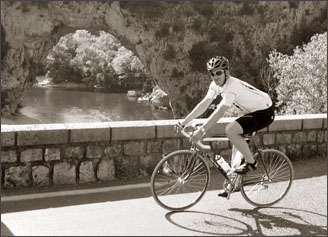Cycling in France
It's said the government can fall, taxes double and trains grind to a
halt in July and the French won't notice - there's only one thing they
care about: a cyclist in a yellow jersey puffing his way across most of
their country at an average of 40kmh (25mph).
 The Tour de France (Le Tour, to those in the know) was the brainchild
of newspaper publisher Henri Desgrange. The first race was held in 1903,
when 21 of the 60 starters finished the grueling 2428km (1505mi) route. The Tour de France (Le Tour, to those in the know) was the brainchild
of newspaper publisher Henri Desgrange. The first race was held in 1903,
when 21 of the 60 starters finished the grueling 2428km (1505mi) route.
These days, it's gotten even longer, and along the way it's become
the world's biggest annual sporting event. Wherever it goes, highways
are blocked off hours before the colorful parade of cyclists stream past
in a blur, cheered on by enthusiastic spectators and followed by TV
cameras mounted on motorbikes, and up to a dozen helicopters.
Every July, 189 of the world's elite cyclists (usually in 21 teams of
nine), plus their massive entourages, take on a route traversing more
than 3000km (1860mi) through much of France, including the Alps and the
Pyrenees, and regularly straying into neighboring countries. Even
Ireland has hosted the first leg, in 1998.
The maillot jaune, the yellow leader's jersey, is revered across the
world of cycling like nothing else: it's awarded after every stage in
the race and to win it, even for a day, can make a rider's career. Other
jerseys to look out for are green, for points leader, and polka dot, for
'King of the Mountains.'
The Tour de France is much more than a race - many years it takes on
soap opera proportions. In its early days, it was not unheard of for
cyclists to catch a train or a ride in a car to the finish, and fist
fights are only now (in the era of worldwide TV audiences) a rarity. A
drugs controversy enveloped the 1998 race to the point of absurdity.
And, though it wasn't a government coup, a tax hike or train strike,
stop the nation it did.
|
